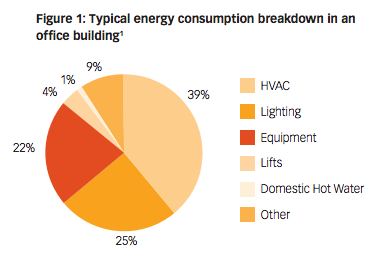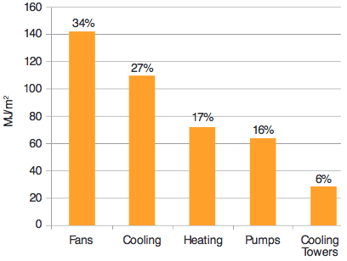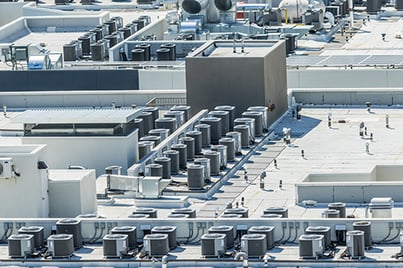Many believe that a smart building has been enhanced with intelligent systems and implements green building concepts. That is far from the truth. A smart building uses a combination of multiple technologies, automated controls and decision-supporting software that provides a rapid and responsive environment. Frequently, they help in enhancing the efficiency and operational effectiveness of building systems like HVAC, while also increasing reliability and robustness. Reduced energy consumption and greater operational efficiencies often result.
Smart buildings achieve all this and more with the help of sensors. Sensors in combination with robust cloud software platforms help communicate, manage, automate and control the systems remotely 24x7x365.
The Internet of Things (IoT) mobilizes advanced technologies to program automatic adjustments by monitoring various environmental measures such as temperature, humidity, light and motion in the building. An example market report expects the smart building market to grow from an estimated USD 7.42 Billion in 2017 to USD 31.74 Billion by 2022, at a Compound Annual Growth Rate (CAGR) of 33.7% from 2017 to 2022.
HVAC: The New Frontier in Building Efficiency
A well-known fact states that buildings consume about 40% of the energy consumption in the world. Out of this consumption, HVAC systems represent the largest consumers. Certainly, this comes as no surprise because HVAC systems perform one of the most essential functions of delivering comfort to building occupants. The amount of energy that HVAC systems consume depends on many factors. The building location, climate, temperatures during the day and night, room occupancy, building age, windows and insulation, and so on, can drastically change the heating/cooling demands placed on the HVAC systems. Hence, automation and control of HVAC systems has become a complex task; high levels of energy efficiency can result if done correctly.
Figure 1 provides insight to a typical profile of energy consumption in a commercial building. HVAC and lighting stand out with estimated percentages of 39% and 25%, respectively, of the total energy budget in a building.

Source: Fact Sheet of HVAC energy consumption
Applying smart building technology to HVAC systems has the potential to generate large energy efficiencies in the enterprise. Technologies such as IoT can help you meet your current and future energy goals in your building. Below, we take a look at different ways smart building technology can give you the critical edge in gaining maximum impact from your HVAC systems.
1. Energy Efficiency
Smart Buildings can incorporate a variety of communication technologies that enable integration with various HVAC systems in a building. Available energy efficiency opportunities will depend on the current HVAC infrastructure installed within the building.
Remote Management/Scheduling
Many buildings have not been equipped with a Building Automation System (BAS). Older buildings or small/medium sized buildings may not justify the prohibitive expense of installing a modern BAS. Typically, these types of buildings have unconnected HVAC sub-systems that operate independently. As such, they rely on manual facility management, which can produce inconsistent performance with respect to energy budgets. Too often, for example, HVAC sub-systems can rely on manual establishment and modification of temperature setpoints.
IoT brings remote visibility to disconnected HVAC sub-systems. In a simple example, IoT devices can interface with stand-alone thermostats and present a cloud-interface for management and control of that thermostat. This effectively creates a type of virtual BAS. This example use case provides large energy savings opportunities in defined HVAC zones such as small retail spaces, construction or educational trailers, individual tenant spaces, or any commercial or industrial space featuring limited smart building functionality.
Advanced Sensor Integration
Even the most advanced BAS has access to limited sensor data such as temperature and humidity. Certainly, this can compromise automated HVAC control loops programmed therein. Smart HVAC systems will increasingly incorporate additional sensor data to deliver maximum comfort to building occupants.
Is your office too hot or too cold? The fact that most would agree points to the insufficiency of the temperature data available to the HVAC system. Most heating/cooling zones don’t have enough temperature sensors. The limited temperature data they do have provides only a coarse level of temperature control. Additional temperatures sensors that cover the entire heating/cooling zone will provide fine-grained temperature controls.
This example of fine-grained temperature controls has arisen because of the need for better data in the HVAC control loop. Don’t get put off by the emphasis on tenant comfort. This example points to the current overhaul of the traditional model of HVAC infrastructure. Additional data based on weather forecasts, occupancy schedules, personal occupant preferences, Indoor Air Quality (IAQ), or any additional factor, can be aggregated in the cloud to provide advanced HVAC controls that leverage IoT.
Unit Efficiency
 HVAC systems include various components. As noted, HVAC consumes about 39% of the building’s total energy consumption. This consumption can be further broken down into individual HVAC system components.
HVAC systems include various components. As noted, HVAC consumes about 39% of the building’s total energy consumption. This consumption can be further broken down into individual HVAC system components.Sadly, most organizations have little to no visibility into critical HVAC assets such as chillers, cooling towers and Roof Top Units (RTUs). Even if a modern BAS controls the HVAC system, the BAS provides limited insight to individual HVAC unit efficiencies. Certainly, critical HVAC assets that operate outside of manufacturer’s specifications will have poor energy efficiency.
IoT can capture granular data from critical HVAC assets in a building. For example, inexpensive wireless IoT sensors can capture real-time operational data regarding supply/return temperatures, fan speeds, vibration, flow rates, compressor run times, pressure, total asset energy consumption, etc. Thus, the real-time capture of asset-specific data will enable insights into the true operational efficiency of critical HVAC assets. Energy efficiencies will follow naturally after you correct unit inefficiencies.
2. Predictive Maintenance
HVAC systems generally have regular maintenance schedules since they form the heart of any building. This includes general checkups, service and maintenance at pre-determined time periods and frequency. What happens, however, when a fault occurs in-between maintenance checks? Further, what happens when a visual inspection does not reveal the existence or potential occurrence of a catastrophic fault?
Certainly, minor issues will grow into major issues. Smart building technology that provides real-time visibility into the operational condition of critical HVAC assets provides the best solution for early Fault Detection and Diagnostics (FDD) and predictive maintenance. Wouldn’t you like to know that your cooling tower was performing outside of the normal specifications established over the last 60 days? The potential for catastrophic failure could implicate costly emergency repairs and severe compromise of tenant operations. Concerns over energy efficiency will seem minor when these issues arise.
The aggregation of real-time data from critical HVAC assets using IoT will enable Artificial Intelligence (AI). AI can be used for advanced analytics that identify potential problems before they manifest.
In many cases, simple HVAC analytics will be sufficient. Real-time alerts and notifications can be programmed to signal warning conditions. For example, you can program alerts and notifications when the RTU airflow diminishes or vibration levels exceed programmable thresholds. These alerts can enable timely maintenance action to prevent catastrophic failures. Thus, the critical issue is access to real-time data that enables assessment of the ongoing operational status of HVAC assets.
3. Real-Time Cloud Visualizations
IoT enables real-time dashboarding via a cloud platform. Anytime, anywhere access to real-time HVAC data changes the game. You need more than your monthly energy consumption for your building. You must go beyond the meter.
Real-time HVAC data will enable real-time alerts and notifications. Your facility management teams will thank you. In general, continuous monitoring of HVAC assets and systems saves time for building engineers because they can remotely monitor equipment operation from their mobile devices while off-site. Their productivity will not depend solely on their time on-site. They will be freed up to address more immediate and urgent issues.
IoT smart building technology connects you to critical HVAC assets in a building. This asset digitization trend will continue to revolutionize the Commercial Real Estate (CRE) market especially as it relates to HVAC. The benchmark data delivered by real-time cloud delivery systems will ensure that you have the tools to crack the code between Smart Building technology and HVAC systems.
Conclusion
Smart Building technology will change your expectations of HVAC system performance in your building. While the potential for energy efficiency can surely be realized, the impact to your enterprise will be profound. Take control of your energy consumption and facility management budget with the tools that today’s IoT Smart Building solutions provide.
Editor's Note: This post was originally published in August 2018 and has been completely revamped and updated for accuracy and comprehensiveness.



